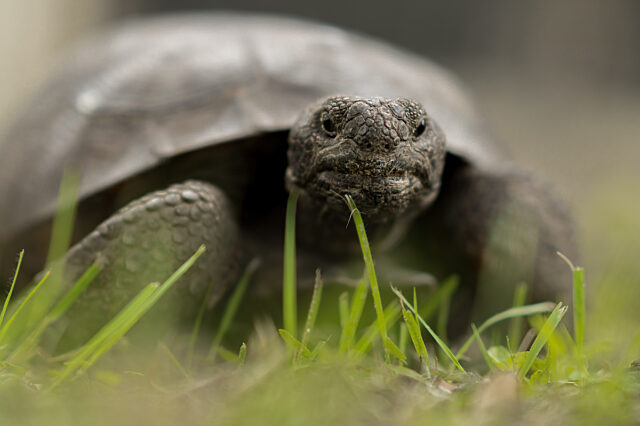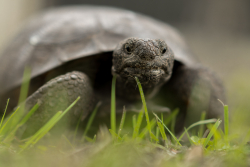UF researchers discover new disease fatal to gopher tortoises

 University of Florida veterinary researchers have discovered a new bacteria strongly associated with death in gopher tortoises, a crucial species because their burrows provide shelter for more than 350 other creatures living in their habitat.
University of Florida veterinary researchers have discovered a new bacteria strongly associated with death in gopher tortoises, a crucial species because their burrows provide shelter for more than 350 other creatures living in their habitat.
The researchers said their findings will be of interest to veterinarians, wildlife biologists and those involved in rehabilitation of gopher tortoises, and could lead to better diagnosis and treatment of the long-living reptiles.
The findings were published recently in Veterinary Microbiology.
“We just recognized a really important disease we didn’t know about because it doesn’t leave a lot of specific clues for pathologists— just dead animals,” said Jim Wellehan, D.V.M., Ph.D., an associate professor at the UF College of Veterinary Medicine and the paper’s senior author. “Now that we know this disease is out there, we can start working on how to prevent and treat it.”
The paper’s first author, Tasha Desiderio, is a UF veterinary student whom Wellehan mentored in the project as part of her undergraduate honors program.
Gopher tortoises are protected by federal law under the Endangered Species Act in western Alabama, Mississippi and Louisiana, and are candidates for possible listing in other parts of their range, including Florida. They can live to be 40 to 60 years old in the wild, and up to 90 years or older in captivity, according to the Florida Fish and Wildlife Conservation Commission.
The UF team discovered the pathogen, a new species of spiral-shaped bacteria from the genus Helicobacter, in three wild gopher tortoises from North Central Florida that were seen at the UF Small Animal Hospital between 2012 and 2019. All three tortoises showed signs of nasal discharge and all rapidly became seriously ill, unlike with previously known causes of upper respiratory disease in tortoises. Examination of fluid from their noses revealed the bacteria.
Sequencing of several genes revealed the novel bacteria. Two of the tortoises died despite treatment attempts. Another one was near death and had to be euthanized.
The researchers then developed a highly specific and rapid genetic sequencing test that was used to survey nasal samples from 31 rehabilitating gopher tortoises.
“What we found was that the mortality of these tortoises significantly correlated with higher Helicobacter loads detected by our tests,” Wellehan said. “That’s a really scarily strong correlation. These tortoises tank and die quickly.”
The gene sequences were compared with other previously characterized Helicobacter strains, including H. pylori, which is associated with stomach ulcers in people. This comparison found that this organism was most closely related to others previously characterized from tortoises. It is also closely related to another new Helicobacter species found in Grand Cayman blue iguanas that Wellehan and his colleagues published about earlier this year. These iguanas are a lizard species that was down to fewer than 25 animals in the wild in 2002.
“These iguanas were found in good body condition, indicating they had not been sick long, and had spiral-shaped bacteria in their blood that we later identified as a Helicobacter that is a pretty close relative of the gopher tortoise species,” Wellehan said, adding that the iguanas died despite treatment and post-mortem examinations would not have found a cause.
Whether the new deadly bacteria is a recently introduced organism or has been present but not recognized is unknown. Florida has the most invasive reptile species of any state and it is possible that an invasive reptile species introduced the pathogen, the scientists said. Previous studies looking at bacterial diversity in North American tortoise noses have not found Helicobacter present in healthy animals.
“Unseasonable temperatures associated with climate change could have also played a role by negatively affecting the reptilian immune system, causing these animals to become more vulnerable to disease,” Wellehan said.
The University of Florida is a worldwide leader in the field of reptile medicine. Authors of the paper include several veterinary specialists in zoological medicine, clinical pathology and anatomical pathology who work for or received training at UF.
“The University of Florida has an expert reptile medicine group that is able to approach disease from many different aspects,” Wellehan said. “The bottom line is helicobacters are now recognized as serious pathogens of some endangered reptiles. They don’t leave specific tracks that are obvious for pathologists to find.”
Media contact: Ken Garcia at kdgarcia@ufl.edu or 352-273-9799.
About the author
